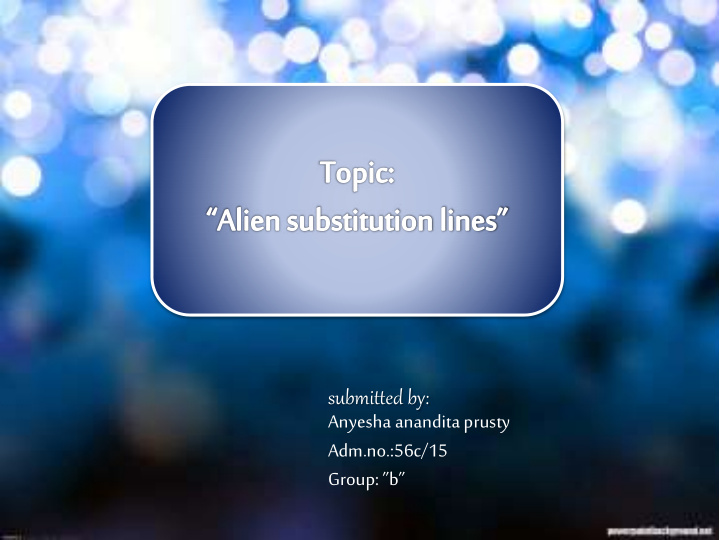



submitted by: Anyesha anandita prusty Adm.no.:56c/15 Group: ”b”
• HYBRIDIZATION: Crossing between 2 genetically dissimilar parent is called hybridization. • DISTANT HYBRIDIZATION: Hybridization between individual from different species belonging to the same genus (interspecific hybridization) or two different genera of same family (intergeneric hybridization) is termed as distant hybridization & such crosses are known as distant crosses or wide crosses. • This is because individuals used for hybridization in such cases are taxonomically more distantly related than different variety of same species.
HISTORY • Thomas Fairchild (1717): The first authentic record of distant hybridization for crop improvement is the production of a hybrid between Carnation ( Dianthus caryophyllus ) & Sweet willian ( Dianthus barbatus ). • Karpechenko (1928): An interesting inter-generic hybrid, Raphanobrassica , was produced. • Rimpu (1890): Produce first intergeneric hybrid triticale which have great potential than raphanobrassica.
INTER-SPECIFIC HYBRIDIZATION
INTERGENERIC CROSSES
Main features of Interspecific or Inter- generic hybridization
Problems associated with wide crosses • Cross incompatibility. • Hybrid inviability • Hybrid sterility. • Hybrid breakdown.
CROSS INCOMPATIBILITY • This is the inability of pollen grains of one species or genus to effect fertilization in another species or genes. • There are 3 main reasons of cross incompatibility: I. Lack of pollen germination. II. Insufficient growth of pollen tube to reach ovule. III. Inability of male gamete to unite with egg cell. • These barriers are known as pre-fertilization barriers.
HYBRID INVIABILITY • This refers to the inviability of the hybrid zygote or embryo. In some cases, zygote formation occurs, but further development of the zygote is arrested. In some other cases, after the completion of the initial stages of the development, the embryo got aborted. • The reasons are : 1. Unfavorable interactions between the chromosomes of the 2 species. 2. Unfavorable interactions of the endosperm with the embryo. 3. Disharmony between cytoplasm & nuclear genes.
HYBRID STERILITY • This refers to the inability of a hybrid to produce viable offspring. The major reason for hybrid sterility is the lack of structural homology between the chromosomes of 2 species. • These irregularities may lead to aberration in chromosome structure. Lack in homology between chromosomes may lead to incomplete pairing between chromosomes. • Sterility caused by structural differences between chromosomes of 2 species can be overcome by amphidiploidisation using colchicines.
HYBRID BREAKDOWN Hybrid breakdown is a major problem in interspecific crosses. When F1 hybrid plants of an interspecific crosses are vigorous & fertile but there F2 progeny is weak & sterile it is known as hybrid break down. So hybrid breakdown hinders the progress of interspecific gene transfer. This may be due to the structural differences of chromosomes or problems in gene combinations.
EMBRYO RESCUE • When embryo fails to develop due to endosperm degeneration, embryo culture is used to recover hybrid plants, i.e. known as embryo rescue. • E.g., H. vulgare x Secale cereale • It is generally used to overcome endosperm degeneration.
TECHNIQUES TO MAKE WIDE CROSSES SUCCESSFUL
ROLE OF WIDE CROSSES IN CROP IMPROVEMENT • Wide crosses are generally used to improve crop varieties for disease & pest resistance, quality adaptation yield etc. these crosses can be even used to develop new crop species. Techniques like alien addition & alien substitution may also be effective. • IMPROVINGING THE CROP PLANTS FOR a) Disease & insect resistance
ALIEN ADDITION LINES • These lines carry 1 chromosome pair from a different species in addition to a normal somatic chromosome complement of the parent species. • When only 1 chromosome from another species is present it is known as alien addition monosome. Alien addition have also been done in rice, sugar beet, cotton, brassicas. • The main purpose of alien addition is the transfer of disease resistance from related wild species. e.g. Transfer of mosaic resistance from Nicotiana glutinosa to N. Tabacum . • The alien addition lines have been developed in case of wheat, oats, tobacco & several other species. • Alien addition lines are of little agricultural importance since the alien chromosome generally caries many undesirable genes. E.g. Reduced growth & short broad leaves in addition to mosaic resistance.
ALIEN SUBTITUTION LINES • When a single chromosome (not a pair) from different species in place of a single chromosome of the recipient species, known as alien substitution monosome. • Alien substitution lines are of 2 types: (1) substitution of a total genome of a cultigen into the cytoplasm of an alien species ( genome substitution) & (2) substitution of a single chromosome or a pair of chromosomes into the chromosome complement of a cultigen (chromosome substitution). • Alien substitution lines have been developed in wheat, cotton tobacco, oats, etc • In case of tobacco, mosaic resistant gene N was transferred from N. glutinosa to N. tabacum line had 24 pairs of N. tabacum chromosomes & 1 pair of N. glutinosa chromosomes. • The alien substitution show more undesirable effects than alien addition & as a consequence are of no direct use in agriculture.
LIMITATION OF DISTANT HYBRIDISATION 1. Incompatible crosses 2. F1 sterility 3. Problems in creating new species. 4. Lack of homology between chromosome of the parental species. 5. Undesirable linkages. 6. Problems in transfer of recessive oligo-genes& quantitative traits. 7. Lack of flowering in F1 8. Problems in using improved varieties in distant hybridisation 9. Dormancy
ACHIEVEMENTS • HYBRID VARIETIES Upland cotton – MCU-2, MCU-5, KHANDWA 1, KHANDWA 2, etc are derivatives of inter-specific hybridisation. Hybrid between Pearl millet x Napier grass- Hybrid Napier which is very popular for its high fodder yield & fodder quality e.g. Jaywant & Yashwant. Inter-specific hybrids in cotton- Varlaxmi, Savitri, DCH-32, NHB-12, DH-7, DH-9 etc.
TH THAN ANK K YO YOU
Recommend
More recommend